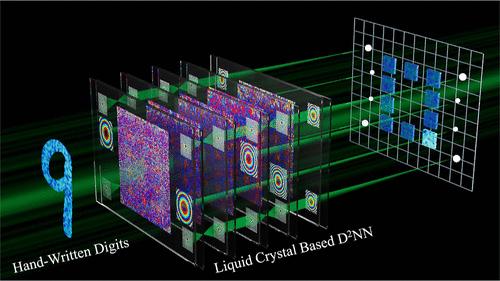用于全光学衍射深度神经网络的可调光诱导液晶缓速器
IF 6.5
1区 物理与天体物理
Q1 MATERIALS SCIENCE, MULTIDISCIPLINARY
引用次数: 0
摘要
全光衍射深度神经网络(D2NN)由基于深度学习设计的无源衍射层组成,利用光以光速执行海量计算,零额外功耗,具有大带宽、高互联和并行处理能力等优势。在本文中,我们介绍了一种利用光诱导液晶(LC)配向技术构建 5 层全光 D2NN 的新方法,以创建基于 LC 的可调相位延迟器作为人工神经层。D2NN 架构利用微尺度多域 LC 缓速器作为光学神经元来操纵入射光的几何相位。在实验过程中,我们系统地模拟像素级位移,以提高对准容差,从而在 x 和 y 方向上以 2 个像素的容差实现对错位干扰的稳健恢复。通过利用外部电压主动调整 LC 缓速器,我们优化了所有网络层的对准策略,在每个 LC 缓速器上都加入了专门设计的凹透镜或凸透镜,以实现 x、y 和 z 方向的精确对准。通过使用来自 MNIST 的手写数据集进行训练,D2NN 的模拟准确率达到 94.17%,误差容限为 2 像素。通过从测试数据集中随机抽取 500 个数字进行实验验证,分类准确率达到 89%。这项研究展示了网络微型化、集成化和与可见光兼容的潜力,强调了全光学 D2NN 在现实世界各种应用中的实际适用性。本文章由计算机程序翻译,如有差异,请以英文原文为准。

Tunable Photoinduced Liquid Crystal Retarders for All-Optical Diffractive Deep Neural Networks
An all-optical diffractive deep neural network (D2NN) consists of deep-learning-based design of passive diffractive layers and uses light to perform massive computations at the speed of light with zero extra power consumption, exhibiting advantages of large bandwidth, high interconnection, and parallel processing capability. In this paper, we introduce a novel approach utilizing a 5-layer all-optical D2NN constructed with photoinduced liquid crystal (LC) alignment technology to create LC-based tunable phase retarders as artificial neural layers. The D2NN architecture leverages microscale multidomain LC retarders as optical neurons to manipulate the geometric phase of incident light. We systematically simulate pixel-level displacements to enhance alignment tolerance during experiments, achieving robust resilience against misalignment interference with a 2-pixel tolerance in the x and y directions. By actively tuning the LC retarders with external voltage, we optimize the alignment strategy for all network layers, incorporating specially designed concave or convex lenses at each LC retarder for precise alignment in the x, y, and z directions. Through training with a handwritten dataset from MNIST, the D2NN demonstrates a simulated accuracy of 94.17% with a 2 pixel misalignment tolerance. Experimental validation achieves a classification accuracy of 89% with 500 random digits from the test dataset. This research showcases the potential for network miniaturization, integration, and compatibility with visible light, underscoring the practical applicability of an all-optical D2NN for diverse real-world applications.
求助全文
通过发布文献求助,成功后即可免费获取论文全文。
去求助
来源期刊

ACS Photonics
NANOSCIENCE & NANOTECHNOLOGY-MATERIALS SCIENCE, MULTIDISCIPLINARY
CiteScore
11.90
自引率
5.70%
发文量
438
审稿时长
2.3 months
期刊介绍:
Published as soon as accepted and summarized in monthly issues, ACS Photonics will publish Research Articles, Letters, Perspectives, and Reviews, to encompass the full scope of published research in this field.
 求助内容:
求助内容: 应助结果提醒方式:
应助结果提醒方式:


